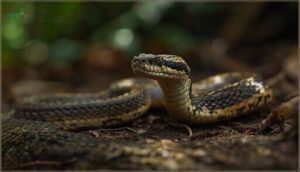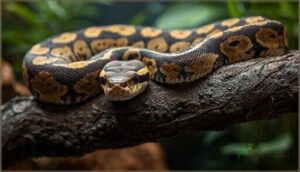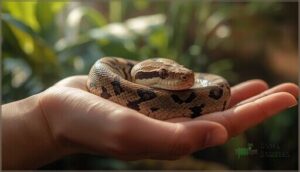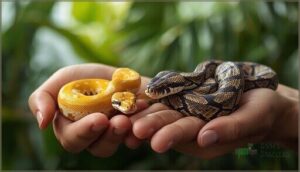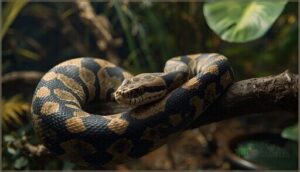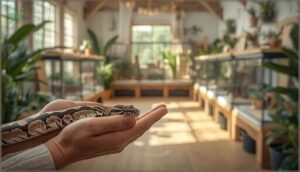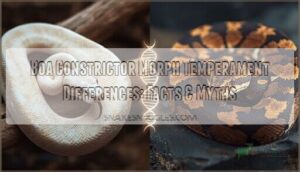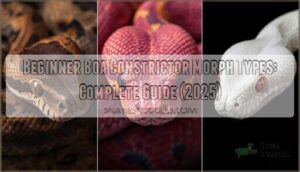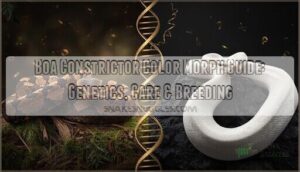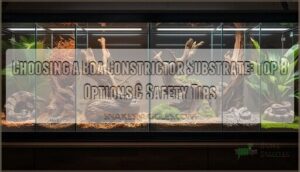This site is supported by our readers. We may earn a commission, at no cost to you, if you purchase through links.
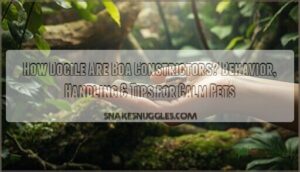
How docile are boa constrictors? With the right lineage, steady handling, and a calm setup, these hefty snakes can surprise even seasoned keepers with their gentle, tolerant attitude. Learning what shapes their temperament can turn confusion into confidence—and help you discover the calm at the core of these misunderstood giants.
Table Of Contents
- Key Takeaways
- Are Boa Constrictors Docile Pets?
- What Makes Boa Constrictors Calm?
- Signs Your Boa is Stressed or Fearful
- How Handling Affects Boa Docility
- Do Boa Constrictors Show Aggression?
- Does Age Impact Boa Constrictor Temperament?
- How Habitat Influences Boa Behavior
- Health Issues That Affect Temperament
- Choosing a Docile Boa Constrictor
- Tips for Keeping Your Boa Calm
- Frequently Asked Questions (FAQs)
- Conclusion
Key Takeaways
- Boa constrictors can be surprisingly gentle when captive-bred, handled regularly, and given a calm, secure environment.
- Genetics, early socialization, and consistent handling are the biggest factors in raising a docile boa.
- Stress signals like hissing, tight coiling, or puffing tell you when your boa isn’t comfortable and needs a break.
- Ideal habitat setup, regular routines, and recognizing each snake’s unique personality help keep your boa calm and easy to handle.
Are Boa Constrictors Docile Pets?
Getting to know a boa constrictor’s temperament is important before bringing one home. Their behavior can surprise new owners in both good and tricky ways.
Let’s look at what makes these snakes such popular pets and what you can expect when choosing their home.
Typical Temperament in Captivity
Boa constrictors in captivity are usually the gentle giants of the snake world. Docile traits stand out most in calm environments with consistent snake handling and gentle interaction. You’ll often notice:
- Slow, patient movements
- Tolerance for regular handling
- Rare defensive gestures
- Relaxed exploration when left undisturbed
Captive behavior reflects both boa constrictor temperament and attentive care. Proper snake handling techniques are essential for maintaining a calm and docile pet.
Differences Between Wild and Captive Boas
You might notice that wild vs captive snake behavior can feel like night and day. Captive boas show steady boa constrictor temperament, with lower stress levels, reliable feeding, and longer captive lifespans. Wild-caught snakes, on the other hand, endure bumpy acclimatization, higher stress, and unpredictable responses, making reptile care more challenging—even experienced hands can feel tested by their behavioral consistency.
Understanding their natural habitat needs is vital for providing ideal care.
Factors Influencing Docility
Getting a docile pet isn’t just luck; it’s a blend of genetic factors, gentle handling techniques, reliable socialization methods, and a stable environment. Some boas are born gentle giants, while others mellow out thanks to frequent, respectful handling and the right setup.
Even physiological influences—like health or diet—shape boa constrictor temperament and how much trust your snake is willing to show.
What Makes Boa Constrictors Calm?
If you want a boa that stays calm and easy to handle, there are a few key things that really matter. Some boas naturally have a more relaxed temperament, while others benefit from the way they’re raised and handled.
Here’s what actually helps keep these snakes mellow.
Genetic Disposition
Ever wonder why some boa constrictors are calm, true gentle giants, while others lean defensive? It all comes down to genetic heritage and the subtle handiwork of behavioral genetics.
Heritability studies and DNA sequencing reveal that temperament factors are inherited. Thanks to genetic variation, there’s a spectrum—from docile pets to more aggressive defensive boas—woven right into their DNA.
Captive-Bred Vs. Wild-Caught Behavior
Breeding methods make all the difference in boa constrictor temperament and handling. Captive-bred boas—raised with trust from day one—tend to be calm, almost sociable, weaving their docility right into daily life.
Wild caught snakes, shaped by survival, can stay edgy and unpredictable. Captivity effects truly show: Snake socialization isn’t equal for all boas.
Early Socialization and Handling
If you start handling your boa early—gently and often, you lay the groundwork for a calmer, more trusting snake. Early interactions matter: consistent, supportive handling reduces defensive behaviors and weaves trust into every touch.
The payoff is clear: docile behavioral outcomes, fewer stress signs, and a snake that sees you as part of its world, not a threat.
Early, gentle handling builds trust, leading to a calmer, docile boa that sees you as a friend rather than a threat
Signs Your Boa is Stressed or Fearful
Even the calmest boa can get spooked or uneasy sometimes. Paying attention to their body language helps you catch warning signs early.
Here are a few things to look out for when your boa is feeling stressed or scared.
Hissing, Puffing, and Defensive Postures
When your boa starts hissing or puffing up, you’ll know it’s putting its Defensive Mechanisms on display. These Threat Responses—tight coils, raised heads, or a suddenly puffed throat—are Stress Signals meant to look intimidating. It’s their way of saying, “Back off!” Watch for:
- Puffing Behavior and Hissing Patterns
- Aggressive Behaviors during stress
- Defensive postures linked to fear
Body Language Cues
Think of your snake as a living mood ring. Posture Analysis is your secret weapon: tight Coiling Patterns and rigid body language scream fear, while loose coils and slow Tail Language mean calm curiosity.
Don’t overlook subtle Facial Expressions and steady Eye Contact—these reveal a lot. Reading these signs helps you adjust handling techniques and prioritize stress reduction at home.
Recognizing Escalating Stress
Ever feel like your boa’s sending out serious “don’t disturb” vibes? Watch for Stress Signals: tight body posture, freezing, frantic escapes, or sudden tail action. These Behavioral Cues mean stress is escalating.
Environmental Triggers—new smells, loud noises—can make it worse. Quick action with Calming Techniques and proper handling keeps trust intact and gets things back to calm.
How Handling Affects Boa Docility
How you handle your boa makes a world of difference in how calm it becomes. Gentle, consistent handling helps build trust and teach your snake that you’re not a threat.
Let’s take a look at a few ways to set up your interactions for success.
Proper Handling Techniques
Got a boa constrictor in your hands? Handling tools like a sturdy hook aren’t just for show—they’re peace-of-mind for you and your snake.
Here’s what you want to master:
- Snake support: Always cradle their full body for stress reduction.
- Gentle touch: Use calm, steady movements—not sudden grabs.
- Read body language: Adjust if you spot signs of tension.
These safe handling techniques build comfort and confidence for both of you.
Building Trust Over Time
You’ve learned how gentle handling matters—now let’s talk about building trust over time. Start with an initial introduction, letting your snake get used to your scent and presence. Through routine, calm contact and watching for positive behavioral indicators, you nurture real comfort. Keep in mind, temperament and response vary by individual, so patience is always your best tool here.
| Trust Factor | What It Looks Like |
|---|---|
| Initial introduction | No handling, just scent |
| Gentle handling | Calm, steady contact |
| Behavioral indicators | Relaxed, loose coils |
| Routine importance | Predictable, safe visits |
Frequency and Duration of Handling
Consistency matters more than marathon sessions. Handle your boa gently 1–2 times a week, keeping each session under 15 minutes. This approach balances socialization and stress—pushing sessions longer, especially for younger snakes, ramps up stress indicators fast.
Watch their body language and adjust your handling techniques as they grow, since age, environment, and temperament all shape what works best.
Do Boa Constrictors Show Aggression?
Boa constrictors are known for being calm, but that doesn’t mean they’re always relaxed. Sometimes, even the calmest snake can act out.
Here’s what can set off more aggressive behaviors, and what you should watch for in your enclosure.
Common Triggers for Aggressive Behavior
When you’re caring for a boa, aggression usually doesn’t come out of nowhere. Common triggers include:
- Handling Mistakes—rough or sudden touches
- Enclosure Stressors—small space or too much activity
- Health Problems—illness or injury
- Temperament Changes—age and hormonal shifts
- Defensive Signals—hissing, body tension, or weaving
Watch for these signs of aggression in boas to keep handling safe.
Differentiating Between Fear and Aggression
Not all fierce-looking boas are angry—sometimes it’s just fear. Fear Signs include hissing, slow tongue flicks, and body tension. Aggression Triggers often make boas strike fast without warning.
Watching their Body Language helps: a fearful boa prefers defensive mechanisms like puffing up, while a truly aggressive snake takes the offensive.
Recognizing these Stress Responses can make your handling much safer.
How to Respond to Aggressive Displays
When you spot Aggression Signs, like hissing or Defensive Postures, stay calm—don’t meet fire with fire. Slow your movements and use a snake hook to ease tension. Stress Reduction starts with quiet confidence.
Avoid handling right after feeding or during shed. Stick with gentle Calming Techniques and gradual Behavior Modification—forging trust over time shapes a calmer temperament.
Does Age Impact Boa Constrictor Temperament?
A boa’s temperament can shift as it grows, and age often plays a bigger role than you might think. Young boas and adults won’t always act the same in your hands. Let’s take a closer look at how their behavior changes through the years.
Juvenile Vs. Adult Behavior
Ever noticed how juvenile boas act like toddlers in a candy store—climbing, exploring, and sometimes overreacting? These snakes have faster growth patterns and more obvious behavioral shifts than adults.
With proper handling and trust-building, their temperament settles as they mature. Good socialization techniques early on help juveniles adapt to new environments, smoothing the path toward a calmer, predictable adult boa.
Changes Over The Lifespan
Throughout a boa’s lifespan, you’ll notice changes in temperament shaped by growth patterns and physiology. Juveniles are curious and energetic, but as adults and seniors, boas slow down and become more set in their ways. Signs of aging—like dulled activity during shedding or senior care needs—remind you their personality always weaves in step with life stage and longevity factors.
- Skin dulling and longer shedding cycles
- Reduced climbing and increased ground time
- Greater sensitivity to stress and routine changes
Handling Recommendations by Age
Handling techniques should shift as your boa grows—what works for a lively juvenile isn’t ideal for a hefty adult. Age-specific handling is key: start slow and gentle with young snakes, building trust bit by bit.
As your boa matures, adapt your approach, balancing calm interaction with respect for their size and changing boa constrictor temperament.
How Habitat Influences Boa Behavior
Where your boa lives can shape how it acts more than you might think. From the space you give it to the feel of the air, even small changes matter.
Here’s what to look for when choosing the right setup.
Enclosure Size and Security
Think of your boa’s snake enclosure like a sturdy fortress—it’s got to be just the right size and escape-proof. Minimum enclosure size matters, but bigger reptile enclosures let boas stretch, climb, and feel secure.
Add hides for safe retreats and mix up the enrichment benefits. A well-planned enclosure setup reduces stress and fosters natural, calm behavior.
Temperature and Humidity Effects
When your boa’s habitat nails the right temperature and humidity, their temperament shifts for the better—irritable, stressed snakes mellow out.
A proper thermal gradient:
- Stops Respiratory Health issues in their tracks
- Lowers Shedding Difficulties
- Limits Viral Replication for a healthier, calm boa
Behavioral Thermoregulation means your boa instinctively finds their comfort zone—all within your well-set enclosure.
Environmental Enrichment for Calmness
Just like you feel at ease in a well-furnished home, your snake benefits from a habitat rich in enrichment items. Habitat complexity—branches to climb, hides to explore, and textured surfaces—offers mental stimulation and physical benefits.
Cognitive stimulation and social interaction (even just seeing you) keep stress reduction front and center, making for a calmer pet and a healthier environment.
Health Issues That Affect Temperament
Boa constrictors aren’t themselves when they’re feeling under the weather. Health issues can sneak up and make even the calmest snake a little cranky.
Here’s what to watch for that might shake up your boa’s usual gentle nature.
Illness-Induced Irritability
Almost every snake owner faces irritability in their boa when health issues crop up. Short tempers, defensive strikes, and sudden withdrawal often point to reptile health issues. Watch for these red flags:
- Sudden aggression or refusal to be handled
- Changes in appetite or mobility
- Unusual postures or wheezing
Regular veterinary care, infection control, and stress management can protect your boa’s docile nature.
Shedding and Brumation Cycles
Handling takes a back seat when your boa enters a shedding or brumation cycle. Cloudy eyes, sluggishness, and defensive hissing often signal Skin Health struggles or Brumation Prep.
Shedding Triggers and drops in Temperature Gradients crank up irritability. Humidity Control becomes your secret weapon—too little, and patches stick; just right, and your snake’s temperament snaps back as skin peels off.
The Role of Proper Nutrition
You’ve just tackled shedding—now let’s talk food. When the Boa constrictor diet and feeding plan hits all the right notes? You get a calmer, steadier snake. Give yours a nutritious, varied, and properly-timed carnivore diet.
Here’s what helps:
- Balanced meals by size
- Steady feeding schedules
- Dietary variety, not monotony
- Smart supplement use
Consistency breeds calm.
Choosing a Docile Boa Constrictor
Finding a calm boa starts long before you bring one home, and it isn’t just luck of the draw. The species, where you get your snake, and even its background all play a part.
Here’s what you need to know as you consider your options.
Researching Species and Morphs
Looking for a docile boa? Start by learning about Species Diversity—there’s more to boas than meets the eye. Each morph’s genetics and color patterns come from specific geographic variants or hybrid breeding. While no morph guarantees calm, red-tailed boas and certain locality types are often prized for their gentle temperament. Research helps you find the right fit for your handling style and trust goals.
Importance of Reputable Breeders
Choosing a boa constrictor from a reputable breeder is your shortcut to a calmer, healthier pet. With breeder accreditation comes strict breeding standards and guaranteed transparency—you’ll get:
- Snake pedigree with documented temperament and lineage
- Health guarantees that support beginner owners
- Honest records that build trust
The right breeder sets you up for smooth handling and predictable behavior, day one.
Beginner-Friendly Boa Options
When you’re searching for beginner-friendly boa options, Colombian boas often take the crown for calm, docile temperament and handling ease. Their manageable size and widespread availability factor into their reputation.
Certain morph temperaments may also offer extra peace of mind. If you’re a beginner, lean toward these boas—they tick the boxes for temperament, handling, and convenience without much fuss.
Tips for Keeping Your Boa Calm
If you want a calm boa, your setup at home makes all the difference.
Let’s look at a few ways you can help your snake relax from day one.
Here’s what to focus on when creating the right space.
Reducing Environmental Stressors
Stress is the enemy of a calm boa. The key? Secure enclosures, the right temperature and humidity gradients, and plenty of enrichment variety.
Gradual transitions into new habitats or setups make a world of difference—think of it as letting your boa explore at its own pace.
Low-stress handling and routine consistency go a long way toward building trust and reducing stress.
Establishing Routines
Want a calm boa with fewer surprises? Get predictable. Feeding schedules, handling consistency, and even cleaning regularity all help shape your boa constrictor’s temperament. Set specific interaction timing and enrichment rotation for smoother handling and less confusion.
Routines build trust and reduce stress—think of them as a gentle handshake your snake actually remembers, session after session.
Recognizing and Respecting Individual Differences
No two boa constrictors are cut from the same cloth. Each comes with unique personalities, comfort levels, and handling preferences. Pay close attention to subtle stress signals or signs of fear—they’ll tell you everything about boa constrictor temperament.
Your job? Practice customized care; weave a routine that fits their animal temperament, not just your schedule, for truly docile companionship.
Frequently Asked Questions (FAQs)
Can boa constrictors coexist peacefully with other pets?
Picture a boa lounging behind locked glass, safe as summer behind screen doors.
Boa constrictors can live peacefully in multi-pet homes—if you follow Pet Safety Tips: secure Snake Enclosures and handle your docile friend with care.
How do boas react to unfamiliar visitors in the home?
When unfamiliar visitors enter your home, boa constrictors often show defensive behaviors like hissing or tense coiling.
With slow introductions and consistent handling, Visitor Stress fades and calm trust grows through effective Socialization Techniques and supportive Household Dynamics.
Are there seasonal changes in boa constrictor behavior?
Imagine your boa syncing up like a smartphone with the seasons—activity and feeding patterns shift as temperatures dip or humidity rises.
Seasonal changes play a big role in boa constrictor behavior, temperament, shedding, and even reproductive cycles.
Do boa constrictors recognize individual owners or caretakers?
Boa constrictors use scent recognition and chemical signals to identify familiar people, responding calmly to known handlers through trust built by regular handling.
While owner bonding looks different than mammals, the habituation process shapes boa constrictor temperament and recognition.
What is the impact of frequent enclosure changes on temperament?
Changing a snake’s enclosure too often is like moving house every month—stress rises, temperament shifts, and handling becomes trickier.
Balancing enrichment with Habitat Familiarity and using Gradual Transitions helps your boa’s Behavioral Adaptability and calm.
Conclusion
Imagine you reach into that enclosure and pause—will calm curiosity meet your hand, or a flash of nerves? The answer really depends on the choices you make.
When you learn how docile boa constrictors are, you discover the quiet, resilient side of these misunderstood snakes. With every thoughtful setup, every gentle touch, you shape a pet as steady as a slow river.
In the end, trust and understanding turn old fears into something almost tranquil.


